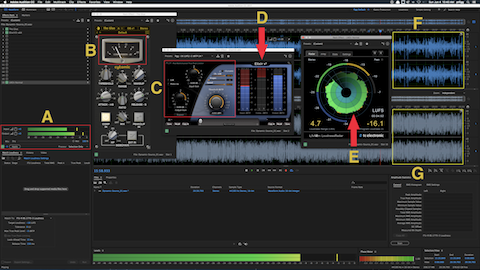The attached image displays a processing workflow designed to optimize Spoken Word intelligibility. The workflow also demonstrates a realtime example of Integrated Loudness compliance targeting.
There are 7 reference point Sections worth noting:
Section A includes the Adobe Audition Effects Rack Signal Level Meters indicating the source (Input) level and the (Output) level. The Output level reflects the results of the workflow’s inserted plugins. The chain includes a Compressor, a Limiter, and a Loudness Meter. Note the level meters indicate signal level. They do not indicate or represent perceptual Loudness.
Section B displays the gain reduction applied by the Compressor at the current position of the playhead. For the test/source audio I determined an average of 6dB of gain reduction would yield acceptable results. The purpose of this stage is to reduce the dynamic range and/or dynamic structure of the Spoken Word resulting in optimized intelligibility AND to prevent excessive down stream limiting. This is an important workflow element when preparing Spoken Word audio for Internet/Mobile, and Podcast distribution.
Section C includes my subjective limiting parameters. The Limiter will add the required amount of gain to achieve a -16.0 LUFS deliverable while adhering to a -1.5 dBTP (True Peak Max). If the client, platform, or workflow requires an alternative Loudness target and/or Maximum True Peak ceiling – the parameters and their mathematical relationship may be altered for customized targeting. Please note the Maximum True Peak referenced in any spec. is more of a ceiling as opposed to a target. In essence the measured signal level may be lower than the specified maximum.
Section D indicates the amount of limiting that is occurring at the current position of the playhead.
Section E displays the user defined Integrated Loudness target located above the circular Momentary Loudness LED (12 o’clock position). The defined Integrated Loudness target is also visually represented by the Radar’s second concentric circle. The Radar display indicates the Short Term Loudness measured over time within a 3 sec. window. The consistency of the Short Term Loudness is evident indicating optimized intelligibility.
Section F displays the unprocessed source audio that lacks optimization for Internet/Mobile, and Podcast distribution. Any attempt to consume the audio in it’s current state in a less than ideal listening environment will result in compromised intelligibility. Mobile device consumption in like environments will exacerbate compromised intelligibility.
Section G displays the processed/optimized audio suitable for the noted distribution platform. The Integrated Loudness, True Peak, and LRA descriptors now satisfy compliance targets. Notice there is no indication of excessive limiting.
-paul.

Excellent article, thank you Paul!
What is you recommended Max LRA for spoken word?
You’re welcome, Pierre –
Since 2013 I’ve recommended an LRA below/no higher than 8 LU for Internet/Mobile/Podcast Spoken Word. This recommendation is based on what was originally recommended by the experts at TC Electronic. In the example above you will notice an LRA somewhere around 5 LU. The fact is I have no problem with LRA values that check in far less than 8 LU. Note – very low values may indicate excessive compression, which at times may be detrimental. Bottom line – shoot for less than 8 LU. Low values are fine providing the audio quality is not compromised.
-paul.
Can you identify the specific plug-ins you employed in this shot? Also, the meaning of LRA?
Hi Dave,
The Compressor is The Glue by Cytomic. It’s an SSL Bus Compressor emulation.
The Limiter is Elixir by Flux. Read my detailed workflow documentation.
The Loudness Meter is LM2n by TC Electronic.
LRA is the Loudness Range descriptor. It’s the statistical variation of loudness over time. It can be associated with dynamic range. It represents the differences between average soft and average loud parts of an audio segment. It helps operators decide whether dynamic range compression is necessary. I get into it here.
-paul.
Helpful as always, thank you Paul.
You’re welcome, Curtis.
-paul.